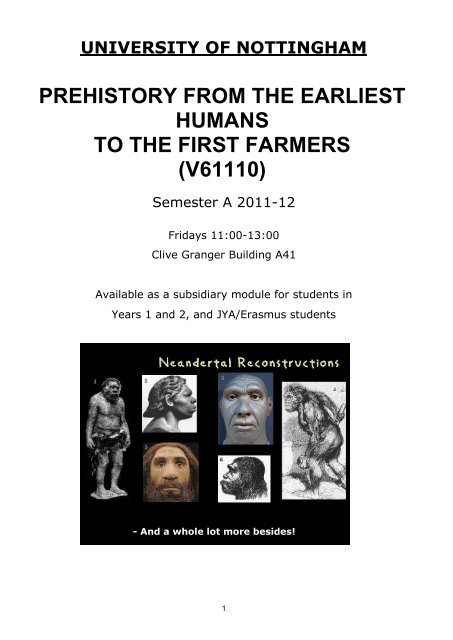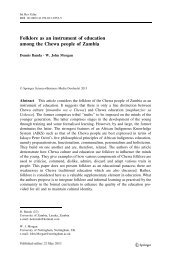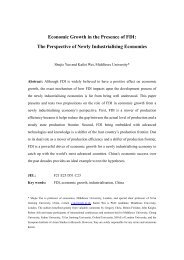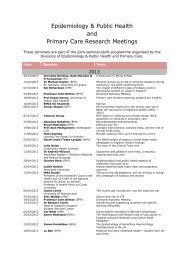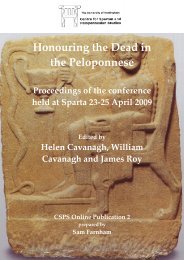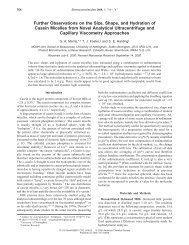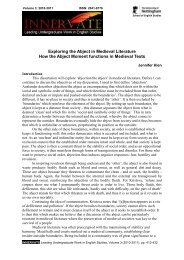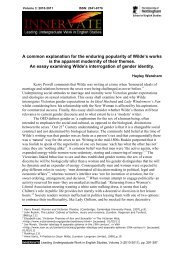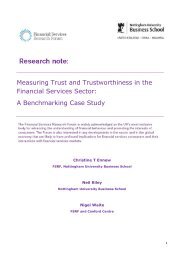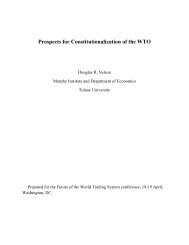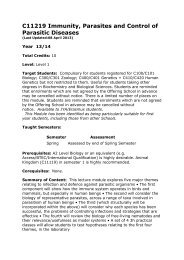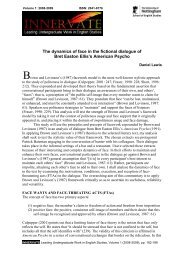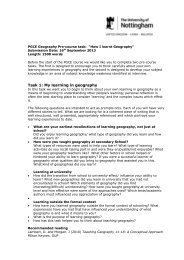Prehistory from the Earliest Humans - The University of Nottingham
Prehistory from the Earliest Humans - The University of Nottingham
Prehistory from the Earliest Humans - The University of Nottingham
Create successful ePaper yourself
Turn your PDF publications into a flip-book with our unique Google optimized e-Paper software.
UNIVERSITY OF NOTTINGHAM<br />
PREHISTORY FROM THE EARLIEST<br />
HUMANS<br />
TO THE FIRST FARMERS<br />
(V61110)<br />
Semester A 2011-12<br />
Fridays 11:00-13:00<br />
Clive Granger Building A41<br />
Available as a subsidiary module for students in<br />
Years 1 and 2, and JYA/Erasmus students<br />
- And a whole lot more besides!<br />
1
<strong>Prehistory</strong> <strong>from</strong> <strong>the</strong> <strong>Earliest</strong> <strong>Humans</strong> to <strong>the</strong> First Farmers (V61110)<br />
Convener: Dr Hamish Forbes<br />
email: hamish.forbes@nottingham.ac.uk<br />
phone: ext. 14843<br />
<strong>of</strong>fice: B31 Humanities Building<br />
Offering School: Humanities<br />
Offering Department: Archaeology<br />
Level: 1<br />
Total Credits: 10<br />
Prerequisites: None<br />
Co-requisites: None<br />
Method and Frequency <strong>of</strong> Class: lectures amounting to 2 hours per week plus three seminars/artefact<br />
handling sessions. <strong>The</strong>re will be an open plenary discussion session at <strong>the</strong> end <strong>of</strong> <strong>the</strong> module.<br />
Method <strong>of</strong> Assessment: one 2.0 hour exam (100% <strong>of</strong> total mark)<br />
Early Bronze Age daggers: central Europe<br />
Ice Age art: mammoth <strong>from</strong> Rouffignac cave, France<br />
2
<strong>University</strong> Regulations on Attendance:<br />
Students must attend all teaching activities necessary for <strong>the</strong> pursuit <strong>of</strong> <strong>the</strong>ir studies, undertake all<br />
associated assessments and attend meetings and o<strong>the</strong>r activities as required by <strong>the</strong>ir School or <strong>the</strong><br />
<strong>University</strong>. Where students face difficulty in attending sessions or undertaking assessments and<br />
examinations, it is <strong>the</strong>ir responsibility to inform <strong>the</strong>ir School <strong>of</strong> this fact and to provide a satisfactory<br />
explanation. Please see http://www.nottingham.ac.uk/quality-manual/study-regulations/attendance.htm<br />
for fur<strong>the</strong>r details on attendance regulations at <strong>the</strong> <strong>University</strong>.<br />
Individual Schools and Departments have systems in place to monitor attendance during <strong>the</strong> academic year.<br />
Unauthorised absences are reported to <strong>the</strong> Registry and recorded as appropriate. Where students are<br />
absent without authorisation, to <strong>the</strong> point that it is not possible to continue with <strong>the</strong> course, <strong>the</strong> Registry will<br />
write to <strong>the</strong> student stating that <strong>the</strong>y will be deemed to have withdrawn <strong>from</strong> <strong>the</strong> <strong>University</strong> and <strong>the</strong>ir<br />
student record will be amended to show that <strong>the</strong>y have withdrawn.<br />
Where required <strong>the</strong> <strong>University</strong> will report non-attendance to appropriate authorities including <strong>the</strong> UK Border<br />
Agency.<br />
Departmental attendance policy:<br />
Lack <strong>of</strong> attendance can result in very serious penalties (see <strong>the</strong> Quality Manual for <strong>the</strong> <strong>University</strong> Regulations<br />
on Attendance:<br />
http://www.nottingham.ac.uk/academicservices/qualitymanual/studyregulations/attendanceprocedures.as<br />
px).<br />
You should note that where students are absent without authorisation, to <strong>the</strong> point that it is not possible to<br />
continue with <strong>the</strong> course, <strong>the</strong> Registry will write to <strong>the</strong> student stating that <strong>the</strong>y will be deemed to have<br />
withdrawn <strong>from</strong> <strong>the</strong> <strong>University</strong> and <strong>the</strong>ir student record will be amended to show that <strong>the</strong>y have withdrawn.<br />
Where required <strong>the</strong> <strong>University</strong> will report non-attendance to appropriate authorities including <strong>the</strong> UK Border<br />
Agency.<br />
Attendance at Lectures and Seminars is compulsory and all students will be required to sign an attendance<br />
register at each session. If you cannot attend, you must inform <strong>the</strong> Departmental Office by e-mailing both<br />
archaeology-enquiries@nottingham.ac.uk and <strong>the</strong> Module Convenor stating your reason for absence. Any<br />
student who is seemed to have unsatisfactory attendance for lectures and seminars will be issued a warning<br />
by <strong>the</strong> department and may be called for interview. Attendance will be considered at exam boards.<br />
It is <strong>the</strong> responsibility <strong>of</strong> <strong>the</strong> student to ensure <strong>the</strong>y attend lectures and seminars and that <strong>the</strong>y make <strong>the</strong><br />
department aware <strong>of</strong> any extenuating circumstances <strong>the</strong>y may have.<br />
Two examples <strong>of</strong> Ice Age art<br />
3
Marking criteria:<br />
Your work will receive one <strong>of</strong> <strong>the</strong> marks listed in <strong>the</strong> left-hand column – <strong>the</strong> descriptors for each class <strong>of</strong><br />
work are provided in <strong>the</strong> columns to <strong>the</strong> right.<br />
Exceptional<br />
Class I<br />
quality<br />
100<br />
98<br />
95<br />
92<br />
90<br />
Class I<br />
quality<br />
88<br />
85<br />
82<br />
80<br />
-------<br />
78<br />
75<br />
72<br />
70<br />
Class<br />
II.i<br />
quality<br />
68<br />
65<br />
62<br />
60<br />
Class<br />
II.ii<br />
quality<br />
58<br />
55<br />
52<br />
50<br />
Knowledge and understanding Pr<strong>of</strong>essional and intellectual skills Technical skills<br />
Innovative and original<br />
thought<br />
Exemplary answer to <strong>the</strong><br />
question<br />
Outstanding knowledge<br />
and understanding <strong>of</strong> <strong>the</strong><br />
relevant material<br />
Well-formed in response to existing<br />
debates, with outstanding criticism <strong>of</strong><br />
o<strong>the</strong>rs’ arguments<br />
Exemplary integration <strong>of</strong> wide reading, as<br />
appropriate<br />
Sure handling <strong>of</strong> analytical terms and<br />
critical concepts<br />
Precise, focused argument<br />
Exemplary analysis<br />
Exemplary discussion <strong>of</strong> evidence /<br />
examples<br />
Superb structure, maintained<br />
throughout, that helps to highlight<br />
salient points<br />
Lucid style and accurate English at an<br />
outstanding pr<strong>of</strong>essional standard<br />
Outstanding pr<strong>of</strong>essional<br />
presentation, including referencing<br />
and bibliography as appropriate<br />
At higher levels <strong>of</strong> study, an answer in <strong>the</strong> 90-100 range might contain elements <strong>of</strong> publishable quality (depending<br />
on <strong>the</strong> discipline, topic, and task).<br />
Independence <strong>of</strong> thought<br />
and/or evidence <strong>of</strong><br />
originality, especially at <strong>the</strong><br />
upper range<br />
Comprehensive and effective<br />
answer to <strong>the</strong> question<br />
Excellent, wide-ranging<br />
knowledge and<br />
understanding<br />
Some independence in<br />
thought and approach<br />
Thorough answer to <strong>the</strong><br />
question, covering most or all<br />
aspects<br />
Good to very good<br />
knowledge and<br />
understanding<br />
Adequate to good answer to<br />
<strong>the</strong> question, covering <strong>the</strong><br />
main aspects<br />
Adequate to good knowledge<br />
and understanding<br />
Well-digested and extensive reading (as<br />
appropriate for <strong>the</strong> task)<br />
Sure handling <strong>of</strong> analytical terms and<br />
critical concepts<br />
Accurate analysis and effective criticism <strong>of</strong><br />
o<strong>the</strong>rs’ arguments<br />
Cogent argument, effectively directed to<br />
<strong>the</strong> question<br />
Excellent discussion <strong>of</strong> evidence /<br />
examples<br />
Wide reading (as appropriate), generally<br />
well-digested<br />
Appropriate handling <strong>of</strong> analytical terms<br />
and critical concepts<br />
Critical awareness and satisfactory analysis<br />
<strong>of</strong> different points <strong>of</strong> view<br />
Sound argument, generally well-directed<br />
to <strong>the</strong> question<br />
Good to very good discussion <strong>of</strong> evidence /<br />
examples<br />
Fair amount <strong>of</strong> reading<br />
Some awareness <strong>of</strong> different points <strong>of</strong><br />
view, maybe with some deficiencies in<br />
analysis and characterisation<br />
Serious attempt to make appropriate use<br />
<strong>of</strong> analytical terms and critical concepts,<br />
maybe with some deficiencies<br />
Adequate and generally relevant argument<br />
Some discussion <strong>of</strong> evidence / examples<br />
Excellent structure<br />
Clear writing and accurate English<br />
style<br />
Pr<strong>of</strong>essional presentation, including<br />
referencing and bibliography as<br />
appropriate<br />
Good to very good structure<br />
Generally clear writing and<br />
acceptable English style<br />
Good to very good presentation,<br />
including referencing and<br />
bibliography as appropriate<br />
Generally coherent structure<br />
Some deficiencies in clarity and<br />
English style, but generally adequate<br />
to good<br />
Moderate presentation, including<br />
referencing and bibliography as<br />
appropriate<br />
Typical weaknesses in this class include over-reliance on one or two authorities; some irrelevance; some incoherence in<br />
argument and/or structure.<br />
4
Class III<br />
quality<br />
48<br />
45<br />
42<br />
40<br />
Knowledge and understanding Pr<strong>of</strong>essional and intellectual skills Technical skills<br />
Some aspects <strong>of</strong> <strong>the</strong> question<br />
addressed adequately, but<br />
failure to address important<br />
aspects <strong>of</strong> it<br />
Limited knowledge, with<br />
serious errors and/or<br />
omissions<br />
Limited to adequate reading<br />
Some ability to interpret questions and to<br />
convey information adequately, but weak<br />
argument<br />
Limited discussion <strong>of</strong> evidence / examples<br />
Adequate to weak structure; <strong>the</strong>re<br />
may be some irrelevance<br />
Moderate level <strong>of</strong> fluency and<br />
technical competence, with errors in<br />
grammar and/or vocabulary<br />
Poor presentation, with poor or<br />
perhaps incomplete referencing and<br />
bibliography<br />
S<strong>of</strong>t<br />
Fail<br />
quality<br />
38<br />
35<br />
32<br />
30<br />
Hard<br />
Fail<br />
quality<br />
28<br />
25<br />
22<br />
20<br />
--------<br />
18<br />
15<br />
12<br />
10<br />
--------<br />
8<br />
5<br />
2<br />
0<br />
Could scarcely be considered<br />
a serious attempt at <strong>the</strong> task<br />
Failure to address <strong>the</strong><br />
question adequately<br />
Little evidence <strong>of</strong> knowledge<br />
and/or understanding<br />
Typically brief and/or<br />
incomplete<br />
Could not be considered a<br />
serious attempt at <strong>the</strong> task<br />
whatsoever<br />
Failure to show<br />
understanding <strong>of</strong> <strong>the</strong><br />
question<br />
Failure to show evidence <strong>of</strong><br />
any knowledge and/or<br />
understanding<br />
Typically very brief and/or<br />
incomplete<br />
Little or no evidence <strong>of</strong> relevant reading<br />
Little or no discernible argument<br />
Some demonstrable ability to<br />
communicate information about relevant<br />
material<br />
Failure to show evidence <strong>of</strong> relevant<br />
reading<br />
Extensive incoherence and/or irrelevance<br />
Little ability to communicate information<br />
about relevant material<br />
Little or no discernible structure<br />
Widespread incoherence and/or<br />
irrelevance<br />
Minimal acceptable level <strong>of</strong> fluency<br />
and technical competence;<br />
comprehensible overall even if<br />
characterized by errors in grammar<br />
and/or vocabulary<br />
Poor or very poor presentation, with<br />
poor, incomplete or no referencing<br />
and bibliography<br />
Extensive incoherence and/or<br />
irrelevance<br />
An unacceptable level <strong>of</strong> fluency and<br />
technical competence, characterized<br />
by serious errors in grammar and/or<br />
vocabulary<br />
Very poor presentation, with poor,<br />
incomplete or no appropriate<br />
referencing and bibliography<br />
Star Carr: a Mesolithic camp. Reconstruction by Alan Sorrell<br />
5
MODULE CONTENT, AIMS AND OUTCOMES<br />
Module content: <strong>The</strong> earlier part <strong>of</strong> <strong>the</strong> module introduces students to <strong>the</strong> appearance and evolution<br />
<strong>of</strong> humans and <strong>the</strong> changing sequences <strong>of</strong> material culture (i.e. tools, etc), with special attention to<br />
Europe. <strong>The</strong> time-frame for this section <strong>of</strong> <strong>the</strong> module will be <strong>from</strong> about 5 million years ago to <strong>the</strong><br />
early post-Ice Age (post-Glacial) period, which started about 10,000 years ago. <strong>The</strong> later part <strong>of</strong> <strong>the</strong><br />
module will investigate <strong>the</strong> origins <strong>of</strong> farming and its spread through Europe. <strong>The</strong> adoption <strong>of</strong><br />
metalworking, especially in western Europe, and <strong>the</strong> social changes associated with it will also be<br />
investigated.<br />
Module aims: <strong>The</strong> module gives you an overview <strong>of</strong> <strong>the</strong> appearance and evolution <strong>of</strong> <strong>the</strong> human<br />
species and <strong>the</strong> evidence <strong>of</strong> how past human communities supported <strong>the</strong>mselves. You will be<br />
introduced to some very simple aspects <strong>of</strong> human anatomy and evolutionary <strong>the</strong>ories. You will also<br />
be introduced to <strong>the</strong> ways in which archaeologists interpret <strong>the</strong> remains <strong>of</strong> material culture (tools<br />
and o<strong>the</strong>r artefacts, remains <strong>of</strong> structures, etc.) and to <strong>the</strong> ways in which archaeologists reach<br />
beyond simple questions <strong>of</strong> how people made a living – for example by sociological interpretation <strong>of</strong><br />
burials, items <strong>of</strong> wealth, art, etc. Above all, this module is designed to introduce you to <strong>the</strong> ways in<br />
which archaeologists use <strong>the</strong> bare bones (literally!) and tools <strong>of</strong> <strong>the</strong> past to interpret how humans<br />
lived and died in periods with no written records.<br />
Learning outcomes:<br />
Knowledge and understanding:<br />
an understanding <strong>of</strong> <strong>the</strong> methods by which prehistory is investigated<br />
a basic knowledge <strong>of</strong> human evolution and its archaeological context<br />
a knowledge <strong>of</strong> <strong>the</strong> ways in which archaeologists divide up prehistoric time<br />
Intellectual skills:<br />
an appreciation <strong>of</strong> <strong>the</strong> various challenges which <strong>the</strong> study <strong>of</strong> periods lacking written documents<br />
presents<br />
Pr<strong>of</strong>essional skills:<br />
an understanding <strong>of</strong> <strong>the</strong> methods by which archaeologists interpret <strong>the</strong> material cultural record<br />
to reconstruct extinct societies<br />
a basic knowledge <strong>of</strong> human evolution and its archaeological context<br />
a basic knowledge <strong>of</strong> <strong>the</strong> development <strong>of</strong> human culture in Europe <strong>from</strong> <strong>the</strong> later part <strong>of</strong> <strong>the</strong> last<br />
Ice Age up to <strong>the</strong> appearance <strong>of</strong> metalworking<br />
Transferable (key) skills:<br />
a basic understanding <strong>of</strong> evolutionary <strong>the</strong>ories and <strong>the</strong>ir application in a specific context<br />
an ability to demonstrate knowledge through a written examination.<br />
Neolithic house interior, with<br />
stone furniture. Skara Brae,<br />
Orkney<br />
6
TIMETABLE<br />
Lecture: Fridays, 11.00-13.00<br />
Introduction: What<br />
is prehistory?<br />
Human evolution<br />
Foragers to farmers<br />
Neolithic and Early<br />
Bronze Age Europe<br />
Summary sessions<br />
DATE Lecture No. Lecture topic<br />
07 Oct 1 Sources <strong>of</strong> information for prehistory<br />
2 <strong>The</strong> problem <strong>of</strong> dating: archaeological and geological<br />
time<br />
14 Oct 3 Human descent - a "monkey puzzle tree"<br />
4<br />
5 <strong>The</strong> first humans in Europe and Asia<br />
21 Oct<br />
6 <strong>The</strong> Neanderthals - and <strong>the</strong>ir relatives, <strong>the</strong> Denisovans<br />
28 Oct<br />
04 Nov<br />
7 Hunters <strong>of</strong> <strong>the</strong> last Ice Age in Europe;<br />
8 Cave art<br />
9 Hunters <strong>of</strong> postglacial Europe - <strong>the</strong> Mesolithic<br />
10 <strong>The</strong> domestication <strong>of</strong> plants and animals<br />
11 Nov 11 <strong>The</strong> spread <strong>of</strong> farming in Europe: <strong>the</strong> Mediterranean<br />
zone<br />
12 <strong>The</strong> spread <strong>of</strong> farming in Europe: <strong>the</strong> Linear Pottery<br />
culture<br />
18 Nov 13 <strong>The</strong> spread <strong>of</strong> farming in Europe: TRB & Michelsberg<br />
cultures<br />
14 Later Neolithic in Europe: <strong>the</strong> corded ware question<br />
25 Nov 15 <strong>The</strong> first farmers in Britain<br />
16<br />
02 Dec 17 <strong>The</strong> Copper Age: Beakers in NW Europe<br />
09 Dec 19<br />
20<br />
16 Dec 21<br />
22<br />
18 <strong>The</strong> Early Bronze Age: <strong>the</strong> Unetice culture<br />
Video, followed by discussion<br />
Exams review<br />
Reconstruction <strong>of</strong> a Neolithic burial<br />
mound. Fussell’s Lodge, an ear<strong>the</strong>n long<br />
barrow near Salisbury<br />
7
READINGS<br />
ACADEMIC HEALTH WARNINGS:-<br />
Don’t believe everything you read!<br />
Using web sites<br />
<strong>The</strong> websites listed here are intended to give you access to a wide range <strong>of</strong> information. Many <strong>of</strong> <strong>the</strong>m are<br />
not however proper academic sources, and it is recommended that when you are writing any academic<br />
essays and projects you cite information <strong>from</strong> published books and journal/e-journal articles and do not use<br />
web sites as sources.<br />
Web sites on archaeological topics:<br />
<strong>The</strong>re are some very good web sites on archaeological issues. <strong>The</strong>re are o<strong>the</strong>rs which are produced by people<br />
with very strange and sometimes dangerous ideas, so if possible stick with those listed here. All <strong>the</strong> sites<br />
listed here were checked within a month prior to <strong>the</strong> start <strong>of</strong> <strong>the</strong> module. However, that does not guarantee<br />
that <strong>the</strong>y will still be live when you decide to use <strong>the</strong>m hence why <strong>the</strong>re are generally several alternatives.<br />
Wikipedia entries are written anonymously and <strong>the</strong>re is no really effective quality control over content.<br />
However, those recommended here were considered to be reasonably accurate and helpful at <strong>the</strong> time <strong>the</strong>y<br />
were checked. Wikipedia sites are always subject to change, though, so be especially careful when reading<br />
<strong>the</strong>m and think about how reliable <strong>the</strong> information seems to be.<br />
Do I have to do all <strong>the</strong>se readings? Definitely not. <strong>The</strong> wide range <strong>of</strong> choices <strong>of</strong> paper references is <strong>the</strong>re<br />
because some readings may be out on loan. <strong>The</strong> range <strong>of</strong> web sources is given to suit students’ differing<br />
needs: some students may want something pretty basic while o<strong>the</strong>rs may want greater depth.<br />
* an asterisk indicates <strong>the</strong> best or most important readings on a particular topic.<br />
General introductory reading<br />
CHAMPION, T., GAMBLE, C., SHENNAN, S. & A. WHITTLE 1984: Prehistoric Europe, London: Academic Press.<br />
[CC161.P7]<br />
CLARK, G. 1977: World prehistory in new perspective, Cambridge: Cambridge Univ. Press (3rd edition).<br />
[CC160.C5]<br />
CUNLIFFE; B. 1998, Prehistoric Europe: an illustrated history, Oxford: Oxford Univ. Press. [CC161.O9]<br />
DARVILL, T. 2010: Prehistoric Britain, 2 nd Ed. London: Routledge. [DA140.D2]<br />
HUNTER, J., & I. RALSTON 1998: <strong>The</strong> archaeology <strong>of</strong> Britain: an introduction <strong>from</strong> <strong>the</strong> Upper Palaeolithic to <strong>the</strong><br />
Industrial Revolution, London: Routledge. [DA144.A7]<br />
MEGAW, J.V.S. & D.D.A. SIMPSON 1979: Introduction to British prehistory, Leicester: Leicester Univ. Press.<br />
[DA140.M4]<br />
RENFREW, C. (ed.) 1974: British <strong>Prehistory</strong>. A New Outline, London: Duckworth. [CC161.R4]<br />
SCARRE, C. 2005: <strong>The</strong> Human Past: World <strong>Prehistory</strong> and <strong>the</strong> development <strong>of</strong> human societies, London: Thames<br />
and Hudson [oversize GN281 HUM]<br />
http://www.nhm.ac.uk/nature-online/life/human-origins/index.html <strong>The</strong> Natural History Museum’s pages on<br />
human evolution – a good source <strong>of</strong> basic information, with interactive pages, etc.<br />
8
Reading for Lectures 1 & 2: What is prehistory? <strong>The</strong> problem <strong>of</strong> dating: archaeological and geological time.<br />
BOWEN, D.Q., 1978: Quaternary Geology: A stratigraphic framework for multidisciplinary work. [George Green<br />
Library, QE696.BOW]<br />
CLARK, J.G.D. (Grahame), 1977: World <strong>Prehistory</strong>: in new perspective. Cambridge: Cambridge Univ. Press. 3 rd<br />
edition. Chapter 1. [CC160.C5]<br />
DANIEL, G.E., 1962, <strong>The</strong> idea <strong>of</strong> prehistory. Harmondsworth: Penguin. [CC100.D2] – also updated edition by G.<br />
Daniel & C. Renfrew 1988: Edinburgh: Edinburgh Univ. Press. [CC100.D2]<br />
DANIEL, G.E., 1967: <strong>The</strong> origins and growth <strong>of</strong> archaeology. Harmondsworth: Penguin [CC100.D2]<br />
DANIEL, G.E., 1975: A hundred and fifty years <strong>of</strong> archaeology. London: Duckworth. [CC100.D2]<br />
* DANIEL, G.E., 1981: A Short History <strong>of</strong> Archaeology. London: Thames & Hudson [CC100.D2]<br />
LOWE, J.J. & M.J.C. WALKER (John J.),1997 [2 nd ed.]: Reconstructing quaternary environments. Harlow: Longman.<br />
[QE696 LOW]<br />
WEST, R.G. 1968 [2nd ed. 1977]: Pleistocene geology and biology. London: Longman. [George Green Library,<br />
QE696.WES]<br />
Stratigraphy:<br />
* http://id-archserve.ucsb.edu/Anth3/Courseware/Chronology/01_Contents.html - stratigraphy in archaeology.<br />
See sections: “Introduction”, “Superposition”, “Stratigraphy”<br />
http://www.pastperfect.org.uk/archaeology/stratig.html<br />
http://en.wikipedia.org/wiki/Stratification_(archeology)<br />
Uniformitarianism:<br />
Note: <strong>The</strong>re are especially large numbers <strong>of</strong> sites on this subject run by religious fundamentalists. <strong>The</strong>y attempt<br />
to undermine <strong>the</strong> basics <strong>of</strong> geology, which threatens literalist/fundamentalist interpretations <strong>of</strong> religious<br />
literature. <strong>The</strong> sites below are reliable:<br />
* http://www.physicalgeography.net/fundamentals/10c.html<br />
Three Age System:<br />
*http://www.bbc.co.uk/history/trail/archaeology/overview/notepads_laptops_03.shtml - a brief overview: part<br />
<strong>of</strong> <strong>the</strong> BBC’s archaeology web pages.<br />
Typology:<br />
Colin Renfrew and Paul Bahn (eds) 2005: Archaeology: <strong>the</strong> key concepts, London: Routledge [CC165.A7]<br />
Colin Renfrew and Paul Bahn (eds) 2004: Archaeology: <strong>the</strong>ory, methods and practice, London: Thames and<br />
Hudson (4 th edition) [CC75.R4]<br />
* http://www.staff.ncl.ac.uk/kevin.greene/wintro/chap4.htm#2 – an archaeological dictionary with a very brief<br />
entry.<br />
<strong>The</strong>re are few web sources on archaeological typology which are really helpful. However, <strong>the</strong> Wikipedia page is<br />
pretty good:<br />
* http://en.wikipedia.org/wiki/Typology_(archaeology) and almost exactly <strong>the</strong> same at:<br />
* http://dic.academic.ru/dic.nsf/enwiki/1405001<br />
Tree ring dating (dendrochronology):<br />
Baillie, M. G. L. 1995. A slice through time :dendrochronology and precision dating. London :Batsford.<br />
9
* http://www.sonic.net/bristlecone/dendro.html<br />
* http://www.ltrr.arizona.edu/dendrochronology.html<br />
Radiocarbon:<br />
Bowman, S. 1990: Radiocarbon dating, London: British Museum Publications<br />
Renfrew, C. 1999: Before civilization: <strong>the</strong> radiocarbon revolution and prehistoric Europe, London: Pimlico<br />
Press. Originally published over 30 years ago but very readable. Read introductory chapters and<br />
appendix for history <strong>of</strong> <strong>the</strong> development <strong>of</strong> archaeology and <strong>the</strong> scientific basis to radiocarbon dating.<br />
* http://www.c14dating.com/ - a comprehensive site with useful links<br />
*http://www.<strong>the</strong>britishmuseum.ac.uk/<strong>the</strong>_museum/departments/conservation,_doc__science/research/scient<br />
ific_techniques/radiocarbon_dating.aspx - <strong>the</strong> British Museum’s radiocarbon pages: very short overview<br />
Readings for Lecture 3/4: Human descent - a "monkey puzzle tree"<br />
BOYD, R., & J.B. SILK 2003: How humans evolved, New York: W.W. Norton (or earlier editions: 1997 & 2000).<br />
[George Green Library, OversizeQH368.BOY]<br />
CONROY, G.C. 2005 [2 nd edition]: Reconstructing human origins: a modern syn<strong>the</strong>sis, New York: W.W. Norton.<br />
[George Green Library, QH368.CON]<br />
DANIEL, G.E., 1962: <strong>The</strong> idea <strong>of</strong> prehistory. Harmondsworth: Penguin. [CC100.D2] - also updated edition by G.<br />
Daniel & C. Renfrew 1988, Edinburgh: Edinburgh Univ. Press. [CC100.D2]<br />
Jones, S., R. Martin & D. Pilbeam (eds) 1992: <strong>The</strong> Cambridge encyclopedia <strong>of</strong> human evolution, Cambridge:<br />
Cambridge <strong>University</strong> Press [George Green Library, Oversize QH368.CAM]<br />
LOWE, J.J. & M.J.C. WALKER 1997 [2 nd ed.]: Reconstructing quaternary environments. Harlow: Longman<br />
[QE696 LOW]<br />
READER, J., 1988: Missing links: <strong>the</strong> hunt for earliest man, London: Penguin. [George Green Library<br />
QH368.REA] (old, but gives background information to many <strong>of</strong> <strong>the</strong> more famous East African<br />
discoveries).<br />
* Excellent site on human origins with very useful Introduction to current <strong>the</strong>ories <strong>of</strong> human evolution -<br />
http://www.talkorigins.org/faqs/homs/ - <strong>the</strong>re is also regular updating with <strong>the</strong> latest news<br />
* Ano<strong>the</strong>r excellent site with video clips and animations - http://www.becominghuman.org/<br />
Interesting site on human evolution (last updated Aug 2007) - http://www.handprint.com/LS/ANC/evol.html<br />
Institute <strong>of</strong> Human Origins ("Science" page about Lucy, Hadar, etc; good cross-links) -<br />
http://www.asu.edu/clas/iho/<br />
Natural History Museum http://www.nhm.ac.uk/nature-online/life/human-origins/index.html some good<br />
interactive pages<br />
What does it mean to be human? http://humanorigins.si.edu/human-characteristics<br />
Reading for Lectures 5 & 6: <strong>The</strong> first humans in Europe and Asia; Neanderthals – and now Denisovans<br />
DRELL, J.R.R. 2000: “Neanderthals: a history <strong>of</strong> interpretation", Oxford Journal <strong>of</strong> Archaeology 19 (1): 1-24.<br />
[Periodicals C]<br />
10
GAMBLE, C. 1986: <strong>The</strong> Palaeolithic settlement <strong>of</strong> Europe. Cambridge: Cambridge <strong>University</strong> Press. Pp.320-331<br />
& 378-383. [CC180.G2]<br />
GAMBLE, C. 1999: <strong>The</strong> Palaeolithic societies <strong>of</strong> Europe, 2nd ed. Cambridge: Cambridge <strong>University</strong> Press.<br />
[CC180.G2]<br />
Pettitt, P.B. 1999: “Disappearing <strong>from</strong> <strong>the</strong> world: an archaeological perspective on Neanderthal extinction",<br />
Oxford Journal <strong>of</strong> Archaeology 18 (3): 217-240 [Periodicals C]<br />
STRINGER, C.B. & C. GAMBLE, 1993: In search <strong>of</strong> <strong>the</strong> Neanderthals: Solving <strong>the</strong> puzzle <strong>of</strong> human origins.<br />
London: Thames & Hudson. [CC180.S8, also George Green Library]<br />
TRINKAUS, E. & P. SHIPMAN, 1994: <strong>The</strong> Neandertals: changing <strong>the</strong> image <strong>of</strong> mankind, London: Pimlico.<br />
[George Green Library, QH368 TR]<br />
Boxgrove (mid Pleistocene c. 500,000 years ago) -<br />
http://matt.pope.users.btopenworld.com/boxgrove/boxhome.htm<br />
* Dmanisi:<br />
http://www.donsmaps.com/dmanisi.html<br />
http://www.talkorigins.org/faqs/homs/d2700.html<br />
Note that <strong>the</strong> <strong>of</strong>ficial web site, http://www.dmanisi.org.ge/ was not available at <strong>the</strong> beginning <strong>of</strong> October,<br />
but <strong>the</strong> first <strong>of</strong> <strong>the</strong> two recommended sites summarises much <strong>of</strong> <strong>the</strong> content<br />
* Denisovans:<br />
http://www.talkorigins.org/faqs/homs/denisova.html<br />
* Neanderthals:<br />
http://www.talkorigins.org/faqs/homs/mtDNA.html#nucleardna<br />
http://www.talkorigins.org/faqs/homs/species.html#neandertals<br />
Reading for Lectures 7 & 8: Hunters <strong>of</strong> <strong>the</strong> last Ice Age in Europe and <strong>the</strong>ir art<br />
Bahn, P.G. 1998: <strong>The</strong> Cambridge illustrated history <strong>of</strong> prehistoric art, Cambridge: Cambridge Univ. Press,<br />
[N5311.B2]<br />
Bahn, P.G. & J. Vertut 1988: Images <strong>of</strong> <strong>the</strong> Ice Age, New York: Facts on File [OversizeCC181.F8.B2]<br />
Champion, T., C. Gamble, S. Shennan & A. Whittle 1984: Prehistoric Europe, London: Academic Press, pp.89-<br />
112. [CC161.P7]<br />
*Darvill, T. 1987: Prehistoric Britain, London: Batsford, pp.37-50. [DA140.D2]<br />
Gamble, C. 1986: <strong>The</strong> Palaeolithic settlement <strong>of</strong> Europe, Cambridge: Cambridge <strong>University</strong> Press. [CC180.G2]<br />
Gamble, C. 1999: <strong>The</strong> Palaeolithic societies <strong>of</strong> Europe, 2nd ed. Cambridge: Cambridge <strong>University</strong> Press.<br />
[CC180.G2]<br />
*Gibbons, A. 2010: ‘Close encounters <strong>of</strong> <strong>the</strong> prehistoric kind.’ Science. 328(5979): pp. 680-684.<br />
[http://www.sciencemag.org/cgi/content/full/sci;328/5979/680]<br />
Lawson, A.J. 1991: Cave art, Princes Risborough: Shire. [CC180.L2]<br />
Megaw, J. V.S. & D.D.A. Simpson 1979, Introduction to British prehistory, Leicester <strong>University</strong> Press, pp.46-79.<br />
[DA140.M4]<br />
Mellars, P.A. 1974: '<strong>The</strong> palaeolithic and mesolithic', in C. RENFREW (ed.), <strong>Prehistory</strong>. A New Outline, London:<br />
Duckworth, pp.41-99, esp.77 , [DA140.R4]<br />
11
Smith, C. 1992: Late Stone Age Hunters <strong>of</strong> <strong>the</strong> British Isles, London: Routledge [CC170.S5]<br />
Ucko, P.J. & A. Rosenfeld 1967: Palaeolithic cave art, London: Weidenfeld Nicolson. [CC180.U3]<br />
Zilhão, João 2006: “Genes, fossils and culture. An overview <strong>of</strong> <strong>the</strong> evidence for Neandertal-Modern Human<br />
interaction” Proceedings <strong>of</strong> <strong>the</strong> Prehistoric Society Vol 72, 1-20 [Periodicals: C] [This is very heavy-going,<br />
but makes a clear case for absorption <strong>of</strong> Neandertals by incoming Cro-Magnon populations]<br />
Web sites:<br />
http://www.btinternet.com/~ron.wilcox/onlinetexts/onlinetexts-chap2.htm (lower, middle and early upper<br />
Palaeolithic in Britain)<br />
http://www.human-nature.com/darwin/books/tattersall.html (discusses <strong>the</strong> importance <strong>of</strong> creativity (incl.<br />
art) among Cro Magnons)<br />
http://www.hatii.arts.gla.ac.uk/MultimediaStudentProjects/99-00/9608559r/project/html/reality.html<br />
(comprehensive site on understanding cave art. Treats you as an adult but not easy to use)<br />
http://www.2blowhards.com/archives/001173.html (blog site. Ra<strong>the</strong>r populist approach, but a pretty good<br />
summary <strong>of</strong> <strong>the</strong> argument that cave art represents hallucinations)<br />
http://humanorigins.si.edu/evidence/human-fossils/species/homo-neanderthalensis (Neanderthals)<br />
http://humanorigins.si.edu/research/asian-research/hobbits (Homo floresiensis, aka '<strong>the</strong> hobbit')<br />
http://www.archaeology.org/online/news/neanderkid.html (neandertal/modern human hybrid)<br />
http://news.nationalgeographic.com/news/2003/02/0220_030220_humanorigins2.html ('out <strong>of</strong> Africa'<br />
<strong>the</strong>ory and <strong>the</strong> origins <strong>of</strong> behaviours characteristic <strong>of</strong> modern humans)<br />
Web sites for lectures 6, 7 & 8: glaciations, neandertals and anatomically modern hominids<br />
http://www.physicalgeography.net/fundamentals/10ad.html (brief overview <strong>of</strong> ice ages and glaciation)<br />
http://academic.emporia.edu/aberjame/ice/gloss.htm (glossary <strong>of</strong> ice age terms)<br />
http://www.archaeology.org/online/news/neanderkid.html (neandertal/modern human hybrid)<br />
http://news.nationalgeographic.com/news/2003/03/0326_030326_neanderthalthumb.html (neandertal<br />
hands as dextrous as modern human hands)<br />
http://news.nationalgeographic.com/news/2003/05/0514_030514_neandertalDNA.html (neandertal DNA<br />
study)<br />
http://news.nationalgeographic.com/news/2002/03/0306_0306_out<strong>of</strong>africa.html (argument that modern<br />
humans interbred with neandertals)<br />
http://news.nationalgeographic.com/news/2003/04/0410_030410_cannibal_2.html (was cannibalism<br />
normal in early humans?)<br />
http://news.nationalgeographic.com/news/2003/03/0306_030306_neanderthal.html (claim that<br />
neandertals were eliminated by cognitively superior H. sapiens sapiens)<br />
http://news.nationalgeographic.com/news/2003/02/0220_030220_humanorigins2.html (’out <strong>of</strong> Africa’<br />
<strong>the</strong>ory and <strong>the</strong> origins <strong>of</strong> behaviours characteristic <strong>of</strong> modern humans)<br />
http://news.nationalgeographic.com/news/2005/09/0920_050920_neanderthal.html (prolonged<br />
adolescence in humans may have arisen with neandertals)<br />
12
http://news.nationalgeographic.com/news/2006/01/0125_060125_neanderthal.html (neandertals hunted<br />
as well as Cro Magnons)<br />
http://news.nationalgeographic.com/news/2010/05/100506-science-neanderthals-humans-matedinterbred-dna-gene/<br />
(neaderthals and humans share genes)<br />
http://www.sciencemag.org/special/neandertal/feature/index.html (sequencing <strong>the</strong> Neanderthal genome)<br />
http://www.hf.uio.no/iakh/forskning/sarc/iakh/lithic/MOUST/mousterian.html#anchor51768 (illustrations<br />
<strong>of</strong> mousterian tools – generally associated with neandertals)<br />
http://www.hf.uio.no/iakh/forskning/sarc/iakh/lithic/MOUST/upperPal.html (a good overview <strong>of</strong> upper<br />
palaeolithic tools – with pictures)<br />
http://www.hf.uio.no/iakh/forskning/sarc/iakh/lithic/sarc.html (<strong>the</strong> home page for <strong>the</strong> 2 previous pages –<br />
gives detailed discussions <strong>of</strong> o<strong>the</strong>r aspects <strong>of</strong> making and classifying stone tools)<br />
http://anthro.palomar.edu/homo2/mod_homo_5.htm (excellent overview <strong>of</strong> <strong>the</strong> upper palaeolithic – flint<br />
and bone tools, food-getting, art)<br />
http://www.geology.ucdavis.edu/~cowen/History<strong>of</strong>Life/CH20images.html (large range <strong>of</strong> images <strong>of</strong> early<br />
and later hominids, including art. Also good links)<br />
http://witcombe.sbc.edu/ARTHprehistoric.html#paleolithic (large site: lots <strong>of</strong> pictures. Lots <strong>of</strong> links – be<br />
prepared to use your knowledge <strong>of</strong> French for some!)<br />
http://www.crystalinks.com/stoneageflute.html (upper palaeolithic flutes: <strong>the</strong>se seem to be undisputed as<br />
musical instruments)<br />
http://www.btinternet.com/~ron.wilcox/onlinetexts/onlinetexts-chap3.htm (late upper palaeolithic and<br />
Mesolithic in Britain)<br />
Neandertals: skeleton and recent artist’s reconstruction<br />
13
Reading for lectures 9 & 10: Mesolithic and <strong>the</strong> beginnings <strong>of</strong> agriculture<br />
Mesolithic:<br />
Whittle, A. 1996: Europe in <strong>the</strong> Neolithic: <strong>the</strong> creation <strong>of</strong> new worlds, Cambridge: Cambridge <strong>University</strong> Press.<br />
[CC185. W4] – a revised and updated version <strong>of</strong>:<br />
Whittle, A, 1985: Neolithic Europe: a survey, Cambridge: Cambridge <strong>University</strong> Press. [CC185.W4]<br />
Bogucki, Peter, and Pam J. Crabtree, eds. 2004: Ancient Europe 8000 BC – AD 1000. Encyclopedia <strong>of</strong> <strong>the</strong><br />
Barbarian World Vol I, pp.123-156; 167-182 (esp. sections on Iron Gates Mesolithic and Franchthi Cave.<br />
Web sources:<br />
* http://www.calpal-online.de/index.html IMPORTANT: User-friendly site for calibrating “raw” radiocarbon<br />
dates to calendar year dates<br />
* http://mesobrit.tripod.com/ Mesolithic Britain web site<br />
* http://www.geo.arizona.edu/palynology/geos462/02holocene.html - excellent overview <strong>of</strong> Holocene (i.e.<br />
post-glacial) vegetation sequence.<br />
* http://mesobrit.tripod.com/starcarr.html Brief overview <strong>of</strong> <strong>the</strong> important site <strong>of</strong> Star Carr<br />
http://www.britarch.ac.uk/ba/ba48/ba48feat.html and http://www.britarch.ac.uk/ba/ba96/feat3.shtml Two<br />
reports in British Archaeology (scroll down if you cannot find Star Carr article immediately)<br />
http://sites.google.com/site/starcarrfieldwork/videos/<strong>the</strong>-o<strong>the</strong>r-side-<strong>of</strong>-<strong>the</strong>-antler 30 minute video about<br />
Star Carr<br />
Origins and spread <strong>of</strong> agriculture:<br />
http://history-world.org/neolithic.htm Fairly simplified overview. Caution - tends to present <strong>the</strong>ories as fact<br />
http://www.unl.edu/rhames/courses/orig_agri_tur.html Looks at why Near Eastern domesticated plants<br />
spread so rapidly<br />
http://www.mc.maricopa.edu/dept/d10/asb/world_archaeology/lifeways/hg_ag/agriculture.html A<br />
readable overview, based on <strong>the</strong> author’s research project. Possible legibility problems with <strong>the</strong><br />
background<br />
http://biology.plosjournals.org/perlserv/?request=get-document&doi=10.1371/journal.pbio.0030410 Not<br />
easy reading. A detailed argument supporting <strong>the</strong> demic diffusion hypo<strong>the</strong>sis <strong>of</strong> <strong>the</strong> spread <strong>of</strong><br />
agriculture across Europe. Downloadable.<br />
http://www.econ.ku.dk/wpa/pink/2003/0341.pdf A detailed discussion <strong>of</strong> <strong>the</strong>ories explaining <strong>the</strong> origins <strong>of</strong><br />
agriculture. Not for <strong>the</strong> faint-hearted!<br />
Reading for lectures 10 & 11: <strong>The</strong> domestication <strong>of</strong> plants and animals; <strong>the</strong> spread <strong>of</strong> farming in Europe: <strong>the</strong><br />
Mediterranean zone<br />
Near East - archaeology:<br />
*Mellaart, James 1975: <strong>The</strong> Neolithic <strong>of</strong> <strong>the</strong> Near East, chapters 1,2,3 & 9. [DS62.2.M4]<br />
Mellaart, James 1961: "Hacilar: a neolithic village site" Scientific American Vol 205, no.2 (Aug 1961), 86-97.<br />
[Science Library]<br />
*Moore, A.M.T.1979: "A pre-neolithic farmers' village on <strong>the</strong> Euphrates" Scientific American Vol 241, no.2<br />
(August 1979), 50-58. [Science Library]<br />
14
Moore, A.M.T. 1982: "Agricultural origins in <strong>the</strong> Near East: a model for <strong>the</strong> 1980's" World Archaeology Vol 14,<br />
no.2, 224-236.<br />
Clark, J.G.D. 1980: Mesolithic Prelude, chapter 2.<br />
Near East - domestication <strong>of</strong> plants and animals:<br />
Zohary, Daniel, and Maria Hopf: Domestication <strong>of</strong> Plants in <strong>the</strong> Old World, chapters 2 & 3. [GC2554 ZOH]<br />
*Harlan, Jack: Crops and Man, chap 8. [Science SB186 HAR]<br />
Bogucki, Peter, and Pam J. Crabtree, eds. 2004: Ancient Europe 8000 BC – AD 1000. Encyclopedia <strong>of</strong> <strong>the</strong><br />
Barbarian World Vol I, 204-217<br />
Clutton-Brock, Juliet: Domesticated Animals <strong>from</strong> Early Times. [Science SF41.C5]<br />
Harris, David R. (ed) 1996: Origins and Spread <strong>of</strong> Agriculture and Pastoralism in Eurasia.<br />
Spread <strong>of</strong> farming to Europe:<br />
*Bogucki, Peter, and Pam J. Crabtree, eds. 2004: Ancient Europe 8000 BC – AD 1000. Encyclopedia <strong>of</strong> <strong>the</strong><br />
Barbarian World Vol I, pp.201-229<br />
Lichter, Clemens and Recep Meriç (eds) 2005: How did farming reach Europe? Anatolian-European relations<br />
<strong>from</strong> <strong>the</strong> second half <strong>of</strong> <strong>the</strong> 7th through <strong>the</strong> first half <strong>of</strong> <strong>the</strong> 6th millennium cal BC: proceedings <strong>of</strong> <strong>the</strong><br />
international workshop, Istanbul, 20-22 May 2004 Istanbul, Turkey: Ege Yayınları [Oversize GN799.A4<br />
HOW] More advanced discussion<br />
Web sources:<br />
* http://www.thamesandhudsonusa.com/web/humanpast/summaries/ch11.html (useful summary overview<br />
<strong>of</strong> <strong>the</strong> spread <strong>of</strong> <strong>the</strong> Neolithic to <strong>the</strong> whole <strong>of</strong> Europe)<br />
Sou<strong>the</strong>astern European early Neolithic:<br />
*Mellaart, James 1975: <strong>The</strong> Neolithic <strong>of</strong> <strong>the</strong> Near East, chapter 9. [DS62.2.M4]<br />
*Tringham, Ruth 1971: Hunters, Fishers and Farmers <strong>of</strong> Eastern Europe, 68-105. [CC161.T7]<br />
*Bogucki, Peter, and Pam J. Crabtree, eds. 2004: Ancient Europe 8000 BC – AD 1000. Encyclopedia <strong>of</strong> <strong>the</strong><br />
Barbarian World Vol I, 218-229; 233-242<br />
Whittle, A.W.R. 1996: Europe in <strong>the</strong> Neolithic: <strong>the</strong> creation <strong>of</strong> new worlds [CC185.W4]<br />
Whittle, A.R.W.1985: Neolithic Europe: a Survey, chapters 2 & 3 (up to p.66). [CC185.W4]<br />
Whittle, A. W. R. 2003: <strong>The</strong> archaeology <strong>of</strong> people: dimensions <strong>of</strong> Neolithic Life. London: Routledge.<br />
[CC180.W4]<br />
Phillips, Patricia 1980: <strong>The</strong> <strong>Prehistory</strong> <strong>of</strong> Europe, chapter 5, 147-163.<br />
Champion, Timothy, Clive Gamble, Stephen Shennan, Alasdair Whittle 1985: Prehistoric Europe, chapter 5.<br />
[CC161.P7]<br />
Tringham, Ruth; Krstic, Dusan; Kaiser, Timothy; Voytek, Barbara: 1980: "<strong>The</strong> early agricultural site <strong>of</strong> Selevac,<br />
Yugoslavia" Archaeology Vol 33, no. 2, 24-32. [Includes some more general discussion <strong>of</strong> S-E European<br />
neolithic.]<br />
Rodden, R. 1965: "An early neolithic village in Greece" Scientific American Vol 212 no.4, 82-91. [Science Library]<br />
Web sources:<br />
15
http://what-when-how.com/ancient-europe/transition-to-farming-in-<strong>the</strong>-balkans-transition-to-agriculture-<br />
70004000-b-c-ancient-europe/ A discussion <strong>of</strong> <strong>the</strong> spread <strong>of</strong> <strong>the</strong> Neolithic in sou<strong>the</strong>astern Europe<br />
Franchthi cave:<br />
Bogucki, Peter, and Pam J. Crabtree, eds. 2004: Ancient Europe 8000 BC – AD 1000. Encyclopedia <strong>of</strong> <strong>the</strong><br />
Barbarian World Vol I, 179-182<br />
Jacobsen, T.W. 1976: "17,000 years <strong>of</strong> Greek prehistory" Scientific American Vol 234 no.6, 76-89. [Science<br />
Library]<br />
Hansen, J. and J.M. Renfrew 1978: ‘Palaeolithic – Neolithic seed remains at Franchthi Cave, Greece’ Nature<br />
271, 349 – 352 [What it says!]<br />
http://projectsx.dartmouth.edu/history/bronze_age/lessons/les/1.html<br />
http://projectsx.dartmouth.edu/classics/history/bronze_age/lessons/les/1.html#6<br />
http://mathildasanthropologyblog.wordpress.com/2008/07/02/inhabited-for-17000-years-franchthi-cavegreece/<br />
Early neolithic in central and west Mediterranean:<br />
*Whittle, A.W.R. 1996: Europe in <strong>the</strong> Neolithic: <strong>the</strong> creation <strong>of</strong> new worlds [CC185.W4]<br />
*Whittle, A.R.W. 1985: Neolithic Europe: a Survey, 95-113.<br />
Bogucki, Peter, and Pam J. Crabtree, eds. 2004: Ancient Europe 8000 BC – AD 1000. Encyclopedia <strong>of</strong> <strong>the</strong><br />
Barbarian World Vol I, 248-258<br />
Phillips, Patricia 1980: <strong>The</strong> <strong>Prehistory</strong> <strong>of</strong> Europe, chapter 5.<br />
(*)Phillips, Patricia 1975: Early Farmers <strong>of</strong> West Mediterranean Europe, chapters 1,2,3.<br />
Champion, Timothy, Clive Gamble, Stephen Shennan, Alsadair Whittle 1985: Prehistoric Europe, chapter 5.<br />
Web sources:<br />
http://www.stonepages.com/news/archives/001550.html Excavation <strong>of</strong> an Italian site<br />
http://assets.cambridge.org/97805216/62031/sample/9780521662031ws.pdf See section on ‘<strong>The</strong> western<br />
Mediterranean’ (pp11-13). A good overview <strong>of</strong> present views.<br />
http://arheologija.ff.uni-lj.si/documenta/pdf31/31oosterbeek.pdf New trends in <strong>the</strong> study <strong>of</strong> <strong>the</strong> spread <strong>of</strong> <strong>the</strong><br />
Neolithic – not for <strong>the</strong> faint hearted but important for those with a serious interest!<br />
Reading for lecture 12: Spread <strong>of</strong> farming in Europe: <strong>the</strong> Linear Pottery culture<br />
*Whittle, A.W.R. 1996: Europe in <strong>the</strong> Neolithic: <strong>the</strong> creation <strong>of</strong> new worlds [CC185.W4]<br />
*Tringham, Ruth 1971: Hunters, Fishers and Farmers <strong>of</strong> Eastern Europe, 105-137. [CC161.T7]<br />
*Whittle, A.R.W. 1985: Neolithic Europe: a Survey, 66-95. [CC185.W4]<br />
Champion, Timothy, Clive Gamble, Stephen Shennan, Alasdair Whittle 1985: Prehistoric Europe, chapter 5.<br />
[CC161.P7]<br />
*Bogucki, Peter, and Pam J. Crabtree, eds. 2004: Ancient Europe 8000 BC – AD 1000. Encyclopedia <strong>of</strong> <strong>the</strong><br />
Barbarian World Vol I, 259-272<br />
Phillips, Patricia 1980: <strong>The</strong> <strong>Prehistory</strong> <strong>of</strong> Europe, chapter 5, 163-169.<br />
16
*Milisauskas, Sarunas 1976: "Olszanica: an early farming village in Poland" Archaeology Vol 29, no. 1, 30-41.<br />
Soudsky, B. 1962: "<strong>The</strong> neolithic site <strong>of</strong> Bylany" Antiquity Vol XXXVI, 190-200.<br />
Web sources:<br />
http://www.princeton.edu/~bogucki/mosaic.html (good overview <strong>of</strong> <strong>the</strong> spread and development <strong>of</strong> <strong>the</strong><br />
Neolithic in central Europe)<br />
http://en.wikipedia.org/wiki/Linear_Pottery_Culture (major article, based largely on material presented in <strong>the</strong><br />
following 3 sites)<br />
http://archaeology.about.com/od/lterms/qt/lbk.htm (overview)<br />
http://www.donau-archaeologie.de/doku.php/kulturen/linearbandkeramik_english_version (good overview)<br />
http://archaeology.about.com/od/inventions/a/haak.htm (argument for population movement)<br />
http://www.princeton.edu/~bogucki/saa1995.html (overview <strong>of</strong> <strong>the</strong> spread <strong>of</strong> <strong>the</strong> Neolithic to central Europe)<br />
Reading for lecture 13: <strong>the</strong> spread <strong>of</strong> farming in Europe: TRB & Michelsberg cultures<br />
Post-LBK developments in Central Europe: ca. 4000-2500 b.c. ("middle neolithic"):<br />
*Whittle, A.W.R. 1996: Europe in <strong>the</strong> Neolithic: <strong>the</strong> creation <strong>of</strong> new worlds [CC185.W4]<br />
*Whittle, A.R.W. 1985: Neolithic Europe: a Survey, 184-232.<br />
*Bogucki, Peter, and Pam J. Crabtree, eds. 2004: Ancient Europe 8000 BC – AD 1000. Encyclopedia <strong>of</strong> <strong>the</strong><br />
Barbarian World Vol I, 293-310<br />
Champion, T., C. Gamble, S. Shennan, A. Whittle 1985: Prehistoric Europe, chap 5.<br />
Midgley, Magdalena 1992: TRB Culture: <strong>the</strong> First Farmers <strong>of</strong> <strong>the</strong> North European Plain. Edinburgh: Edinburgh<br />
<strong>University</strong> Press<br />
Milisauskas, Sarunas, and Janusz Kruk 1978: "Brononcice: a neolithic settlement in sou<strong>the</strong>astern Poland"<br />
Archaeology Vol 31, no.6, 44-52.<br />
Nogaj-Chach, Jolanta 1991: “<strong>The</strong> stone-packed graves <strong>of</strong> <strong>the</strong> Funnel Beaker culture in Karmanowice, site 35”<br />
Antiquity 65, 628-640. Also available at:<br />
http://www.antiquity.ac.uk/Ant/065/0628/Ant0650628.pdf you may need your university passwords (a<br />
detailed look at a burial site)<br />
Web sources:<br />
http://en.wikipedia.org/wiki/Funnelbeaker_culture<br />
http://www.princeton.edu/~bogucki/mosaic.html<br />
http://www.princeton.edu/~bogucki/landcape.html (detailed article discussing landscape changes LBK-TRB)<br />
http://www.pcl-eu.de/virt_ex/detail.php?entry=01 (Funnel Beaker culture houses)<br />
http://en.wikipedia.org/wiki/Michelsberg_culture (Brief page on <strong>the</strong> Michelsberg culture)<br />
http://whc.unesco.org/en/list/1006 (Michelsberg culture flint mines at Spiennes, Belgium)<br />
Lecture 14: Later Neolithic in Europe: <strong>the</strong> corded ware question<br />
17
Late neolithic (eneolithic/chalcolithic) in Central Europe:<br />
*Whittle, A.W.R. 1996: Europe in <strong>the</strong> Neolithic: <strong>the</strong> creation <strong>of</strong> new worlds [CC185.W4]<br />
*Whittle, A.R.W. 1985: Neolithic Europe: a Survey, 239-263.<br />
Champion, T., C. Gamble, S. Shennan, A. Whittle 1985: Prehistoric Europe, chapter 6.<br />
*Bogucki, Peter, and Pam J. Crabtree, eds. 2004: Ancient Europe 8000 BC – AD 1000. Encyclopedia <strong>of</strong> <strong>the</strong><br />
Barbarian World Vol I, pp.371-382<br />
http://en.wikipedia.org/wiki/Corded_Ware_culture<br />
‘<strong>The</strong> Globular Amphora Culture’: Document on Web CT<br />
http://www.bris.ac.uk/archanth/staff/heyd/Copper1.pdf - lots <strong>of</strong> detail but heavy going<br />
http://www.bris.ac.uk/archanth/staff/heyd/Copper2.pdf - more <strong>of</strong> <strong>the</strong> same!<br />
http://e<strong>the</strong>sis.helsinki.fi/julkaisut/hum/kultt/vk/kriiska/tekstid/05.html - Corded ware sites <strong>from</strong> Estonia – to<br />
save time go straight to <strong>the</strong> “discussion” section<br />
http://www.kar.zcu.cz/texty/TurekND.htm#funerary – see “3. Stone axes in <strong>the</strong> corded ware contexts” Stone<br />
axes as markers <strong>of</strong> social differentiation<br />
Discussions <strong>of</strong> this period in individual countries may be found in <strong>the</strong> following (mostly very out-<strong>of</strong>-date, but<br />
still quite helpful, especially for pictures or charts):<br />
Neustupny, E. and J.: Czechoslovakia before <strong>the</strong> Slavs, chapter VIII.<br />
Jazdzewski, K.: Poland, 92-101.<br />
de Laet, S.J.: <strong>The</strong> Low Countries, chapter VI.<br />
Klindt-Jensen, O.: "Denmark Before <strong>the</strong> Vikings, chapter III.<br />
<strong>The</strong> "secondary products revolution":<br />
*Sherratt, Andrew 1983: "<strong>The</strong> secondary exploitation <strong>of</strong> animals in <strong>the</strong> Old World" World Archaeology Vol 15,<br />
no. 1, 90-104.<br />
Sherratt, Andrew: "Plough and pastoralism: aspects <strong>of</strong> <strong>the</strong> secondary products revolution" in I. Hodder, G.<br />
Isaac, and N. Hammond (eds): Pattern <strong>of</strong> <strong>the</strong> Past. Essays in Honour <strong>of</strong> David Clarke, 261-306.<br />
Bogucki, Peter, and Pam J. Crabtree, eds. 2004: Ancient Europe 8000 BC – AD 1000. Encyclopedia <strong>of</strong> <strong>the</strong><br />
Barbarian World Vol I, pp.325-333<br />
Craig, Oliver E., John Chapman, Carl Heron, Laura H. Willis, László Bartosiewicz, Gillian Taylor, Alasdair<br />
Whittle, Mat<strong>the</strong>w Collins 2005: “Did <strong>the</strong> first farmers <strong>of</strong> central and eastern Europe produce dairy<br />
foods?” Antiquity 79, 882–894 - a probable partial contradiction to <strong>the</strong> <strong>the</strong>ory. Also at:<br />
http://www.antiquity.ac.uk/Ant/079/0882/ant0790882.pdf - but probably only accessible directly at this<br />
URL on campus.<br />
Reading for lectures 15 & 16: <strong>the</strong> first farmers in Britain<br />
*Bogucki, Peter, and Pam J. Crabtree, eds. 2004: Ancient Europe 8000 BC – AD 1000. Encyclopedia <strong>of</strong> <strong>the</strong><br />
Barbarian World Vol I, 276-286<br />
Julian Thomas 1999: Understanding <strong>the</strong> Neolithic, 2 nd ed, London: Routledge<br />
18
I.F. Smith: "<strong>The</strong> neolithic" in Colin Renfrew (ed) British <strong>Prehistory</strong>: a New Outline (Readable outline)<br />
J.V.S. Megaw and D.D.A. Simpson: Introduction to British <strong>Prehistory</strong>, chaps 3 & 4. (More detailed discussion)<br />
A. W. R. Whittle: Neolithic Europe, chap. 6, pp. 219-224, 233-239, 249-50, 261-263.<br />
Possibly see also: R.J.C. Atkinson: "Wayland's Smithy" Antiquity Vol 39, 126-33.<br />
Web sites<br />
http://email.eva.mpg.de/~richards/pdf/Richards_et_al%20Nature2003.pdf – demonstrates a sudden shift <strong>from</strong><br />
heavy reliance on marine resources to land-based cereals and meat in early Neolithic<br />
http://www.dot-domesday.me.uk/develop.htm - an introductory-level site<br />
http://www.dot-domesday.me.uk/henge.htm - introductory level page on henge monuments<br />
http://www.orkneyjar.com/history/tombs/index.html - chambered tombs in Orkney<br />
http://www.knowth.com/neolithic-religion-status.htm - good discussion <strong>of</strong> <strong>the</strong> social context <strong>of</strong> Neolithic burial<br />
monuments<br />
http://www.knowth.com/newgrange.htm - describes <strong>the</strong> passage grave at Newgrange. Follow links to o<strong>the</strong>r<br />
tombs<br />
http://arheologija.ff.uni-lj.si/documenta/pdf31/31thomas.pdf - a really serious discussion about <strong>the</strong> origins <strong>of</strong><br />
<strong>the</strong> Neolithic in Britain.<br />
* http://www.hardav.co.uk/MA%20-%20HTML/chapter%203.htm – major discussion <strong>of</strong> <strong>the</strong> British Neolithic. A<br />
good general text on <strong>the</strong> subject.<br />
* http://www.btinternet.com/~ron.wilcox/onlinetexts/onlinetexts-index.htm - useful site, including periods<br />
o<strong>the</strong>r than <strong>the</strong> Neolithic.<br />
Reading for lecture 17: <strong>The</strong> Copper Age: Beakers in NW Europe<br />
<strong>The</strong> basic text is:<br />
*Harrison, R J 1980: <strong>The</strong> Beaker Folk: Copper Age archaeology in western Europe. London: Thames & Hudson.<br />
[CC185.H2]<br />
General reading, including Continental material.<br />
Champion, T C ET AL 1985 Prehistoric Europe. London & Orlando: Academic Press. [Chapters 6-7.] [CC161.P7]<br />
Harrison, R J 1974 'Origins <strong>of</strong> <strong>the</strong> Bell Beaker cultures', Antiquity 48 (1974), 99-109. [Periodicals C]<br />
*Harrison, R J 1980: <strong>The</strong> Beaker Folk: Copper Age archaeology in western Europe. London: Thames & Hudson.<br />
[CC185.H2]<br />
*Bogucki, Peter, and Pam J. Crabtree, eds. 2004: Ancient Europe 8000 BC – AD 1000. Encyclopedia <strong>of</strong> <strong>the</strong><br />
Barbarian World Vol I, pp.476-484<br />
*Mercer, R J (ed) 1977: Beakers in Britain and Europe. Oxford: BAR (Int. series 26) [especially papers by Case,<br />
Harrison & Shennan.] [OversizeD51.B7/26]<br />
British Beakers: general treatments.<br />
Burgess, C B 1980: <strong>The</strong> age <strong>of</strong> Stonehenge. London: Dent. [Esp. pp. 61-76] [DA140.B8]<br />
Burgess, C B & S J Shennan 1976 '<strong>The</strong> Beaker phenomenon: some suggestions', in Burgess, C B & R Miket (eds)<br />
Settlement and economy in <strong>the</strong> third and second millennia BC, 309-331. Oxford: BAR (British series 33.)<br />
[OversizeDA140.B7/33]<br />
19
*Case, H J 1977 '<strong>The</strong> Beaker culture in Britain and Ireland', in Mercer, R (ed) Beakers in Britain and Europe,<br />
71-101. Oxford: BAR (Int. series 26.) Oxford: BAR. [OversizeD51.B7/26]<br />
Clarke, D L 1966 'A tentative reclassification <strong>of</strong> British Beaker pottery in <strong>the</strong> light <strong>of</strong> recent research',<br />
Palaeohistoria 12 (1966) [1967], 179-197. [Periodicals C]<br />
*Darvill, T C 1987 Prehistoric Britain. London: Batsford. [DA140.D2]<br />
Lanting, J N & J D Van der Waals 1972 'British Beakers as seen <strong>from</strong> <strong>the</strong> Continent', Helinium 12(1972), 20-46.<br />
[Periodicals C]<br />
*Megaw, J V S & D D A Simpson 1979 Introduction to British prehistory. Leicester: Leicester Univ. Press. [pp. 178-<br />
207. 'Traditional'.] [DA140.M4]<br />
Recent journal references:<br />
R.J. Harrison, R. Jackson, M Napthan 1999: “A rich Bell Beaker burial <strong>from</strong> Wellington Quarry, Marden,<br />
Herefordshire” Oxford Journal <strong>of</strong> Archaeology, February 1999, vol. 18, no. 1, pp. 1-16(16) [An intact<br />
Bell Beaker grave with a range <strong>of</strong> “typical” Beaker grave goods.<br />
R. G. Pena 1997: “Bell beakers in <strong>the</strong> sou<strong>the</strong>rn Meseta <strong>of</strong> <strong>the</strong> Iberian peninsula: socioeconomic context and<br />
new data” Oxford Journal <strong>of</strong> Archaeology 16 (2), 187-209<br />
Rojo-Guerra, M.A., Garrido-Pena, R., García-Martinez-de-LagráJuan-Treserras, J., Matamala, J.C. 2006: “Beer<br />
and bell beakers: drinking rituals in copper age inner Iberia” Proceedings <strong>of</strong> <strong>the</strong> Prehistoric Society 72,<br />
243-265.<br />
Neil Brodie 1997: “New perspectives on <strong>the</strong> bell-beaker culture” Oxford Journal <strong>of</strong> Archaeology 16 (3), 297-<br />
314<br />
T. Douglas Price, Gisela Grupe, and Peter Schröter 1998: “Migration in <strong>the</strong> bell beaker period <strong>of</strong> central<br />
Europe” Antiquity 72, 405-411.<br />
Michael J. Allen 2005: “Beaker settlement and environment on <strong>the</strong> chalk downs <strong>of</strong> sou<strong>the</strong>rn England”<br />
Proceedings <strong>of</strong> <strong>the</strong> Prehistoric Society, Vol. 71<br />
Web resources:<br />
http://www.bris.ac.uk/archanth/staff/heyd/Bell1.pdf - a detailed view <strong>from</strong> Germany<br />
http://www.bris.ac.uk/archanth/staff/heyd/Bell2.pdf - bell beaker settlement sites in Germany<br />
http://www.aquincum.hu/oskor/akorabronz.html - beaker period in Hungary<br />
http://www.wiltshireheritage.org.uk/galleries/index.php?Action=3&obID=101&prevID=9 – has a good photo<br />
<strong>of</strong> <strong>the</strong> Upton Lovell necklace<br />
http://www.missgien.net/archer/amesbury_archer.html - <strong>the</strong> Amesbury archer<br />
http://www.bbc.co.uk/history/archaeology/excavations_techniques/king_stonehenge_01.shtml - ditto<br />
*http://www.wessexarch.co.uk/projects/amesbury/archer.html - ditto. Click on <strong>the</strong> You Tube icon at <strong>the</strong><br />
bottom <strong>of</strong> <strong>the</strong> page for a virtual tour <strong>of</strong> <strong>the</strong> Stonehenge area.<br />
Readings for lecture 18: <strong>The</strong> beginnings <strong>of</strong> <strong>the</strong> Bronze Age in Central Europe: <strong>the</strong> Unetice culture<br />
Readings:<br />
A.F.Harding 2000: European societies in <strong>the</strong> Bronze Age Cambridge: Cambridge <strong>University</strong> Press<br />
20
J.M. Coles and A.F. Harding 1979: <strong>The</strong> Bronze Age in Europe: an introduction to <strong>the</strong> prehistory <strong>of</strong> Europe<br />
c.2000-700 B.C.<br />
B. Cunliffe (ed.) 1994: <strong>The</strong> Oxford illustrated prehistory <strong>of</strong> Europe Oxford: Oxford <strong>University</strong> Press<br />
Bogucki, Peter, and Pam J. Crabtree, eds. 2004: Ancient Europe 8000 BC – AD 1000. Encyclopedia <strong>of</strong> <strong>the</strong><br />
Barbarian World Vol II, 3-11; 20-33<br />
Web resources:<br />
http://odur.let.rug.nl/arge/Work/chrono.htm Chronological schemes for <strong>the</strong> Bronze Age in different regions <strong>of</strong><br />
Europe. Note that “Bronzezeit” is German for “Bronze Age”!<br />
http://en.wikipedia.org/wiki/Unetice_culture<br />
http://en.wikipedia.org/wiki/Leubingen - brief description <strong>of</strong> extremely wealthy burial<br />
<strong>The</strong> Nebra skydisk: clever fake or evidence <strong>of</strong> ancient astronomical knowledge?<br />
http://en.wikipedia.org/wiki/Nebra_sky_disk - a reasonably balanced account, indicating that it is still very<br />
uncertain whe<strong>the</strong>r this object is genuine<br />
http://news.bbc.co.uk/1/hi/sci/tech/6722953.stm - ano<strong>the</strong>r balanced account<br />
http://www.youtube.com/watch?v=M1dSMcZbHq4 – short video programme on <strong>the</strong> Nebra skydisk, which<br />
assumes that it is genuine<br />
http://www.youtube.com/watch?v=mR2NM5kSVi0<br />
http://www.youtube.com/watch?v=7fkizDQuWAg <strong>The</strong>se two videos provide over 25 minutes <strong>of</strong> coverage on <strong>the</strong> Nebra<br />
skydisk.<br />
Nebra sky disk<br />
21


